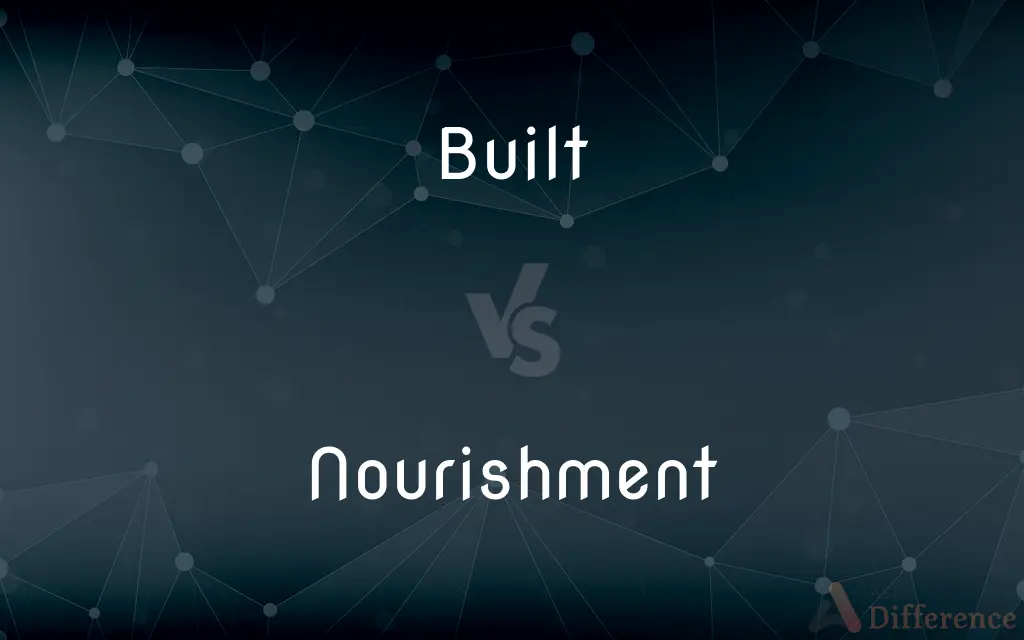Built vs. Nourishment — What's the Difference?
Edited by Tayyaba Rehman — By Urooj Arif — Updated on March 28, 2024
Built refers to something constructed or developed, while nourishment concerns providing nutrients for growth and health.

Difference Between Built and Nourishment
Table of Contents
ADVERTISEMENT
Key Differences
Built pertains to the creation or assembly of structures, objects, or systems, focusing on the physical or developmental aspects of construction. This term is commonly associated with architecture, engineering, and software development, emphasizing the process of bringing various components together to form a cohesive entity. On the other hand, nourishment is centered around the provision of essential nutrients and sustenance required by living organisms, including humans, animals, and plants, to support their growth, health, and overall well-being.
While built environments are a testament to human ingenuity and creativity, manifesting in the form of buildings, bridges, and digital infrastructures, nourishment plays a crucial role in the biological and physiological development of living beings. Nourishment involves a balanced intake of food and nutrients, ensuring that the body receives what it needs for optimal functioning. Whereas, the concept of being built often culminates in a tangible output or result that can be observed and utilized by society.
The term "built" often implies a sense of permanence or durability, reflecting human efforts to create lasting structures or solutions. It encompasses both physical constructions and the development of intangible systems, like software or organizational structures. Nourishment, in contrast, implies a continuous process of providing and receiving sustenance, highlighting the ongoing nature of growth and maintenance of life.
The impact of being built is predominantly external, influencing the environment and the way humans interact with their surroundings. It involves considerations of design, functionality, and sustainability. Conversely, nourishment has an internal focus, with impacts on health, vitality, and the ability to perform and thrive. It encompasses dietary needs, the importance of balanced nutrition, and the effects of nourishment on physical and mental health.
The relationship between built environments and nourishment can be intertwined, as the design and structure of built environments can significantly influence access to nourishment, through factors such as food availability, space for cultivation, and community design that promotes healthy living.
ADVERTISEMENT
Comparison Chart
Definition
The creation or assembly of structures, objects, or systems.
The provision of nutrients needed for growth and health.
Focus
Physical or developmental construction.
Provision of essential nutrients and sustenance.
Implication
Permanence, durability, and utility.
Ongoing process of growth and maintenance of life.
Impact
External, affecting environments and interactions.
Internal, affecting health, vitality, and well-being.
Relationship with Other
Can influence the provision and accessibility of nourishment.
Essential for the health of individuals within built environments.
Compare with Definitions
Built
Structurally formed.
Ancient pyramids were built with precision and skill.
Nourishment
A continuous process.
Nourishment affects every stage of life.
Built
Developed or created.
The software was built using the latest programming languages.
Nourishment
Providing essential nutrients.
Balanced nourishment is vital for healthy development.
Built
Resulting from construction efforts.
The built environment reflects the community's cultural values.
Nourishment
Essential for well-being.
Emotional nourishment is as important as physical.
Built
Constructed or assembled.
The newly built bridge connects two major cities.
Nourishment
Supporting growth and health.
Plants seek nourishment from soil and sunlight.
Built
Pertaining to physical development.
His physique was built through years of training.
Nourishment
Sustenance for living organisms.
Good nourishment involves a variety of foods.
Built
Past tense and past participle of build.
Nourishment
The act of nourishing.
Built
Having a specified physique
A heavily built boxer.
Nourishment
The state of being nourished.
Built
(Informal) Having a well-developed or attractive body
A dancer who is really built.
Nourishment
Something that nourishes; food.
Built
(informal) well-built, muscular or toned.
Nourishment
The act of nourishing or the state of being nourished
Built
(obsolete) Shape; build; form of structure.
The built of a ship
Nourishment
Something that nourishes; food
Built
Inflection of build
Nourishment
The act of nourishing, or the state of being nourished; nutrition.
Built
Shape; build; form of structure; as, the built of a ship.
Nourishment
That which serves to nourish; nutriment; food.
Learn to seek the nourishment of their souls.
Built
Formed; shaped; constructed; made; - often used in composition and preceded by the word denoting the form; as, frigate-built, clipper-built, etc.
Like the generality of Genoese countrywomen, strongly built.
Nourishment
A source of materials to nourish the body
Built
(used of soaps or cleaning agents) having a substance (an abrasive or filler) added to increase effectiveness;
The built liquid detergents
Nourishment
The act of nourishing;
Her nourishment of the orphans saved many lives
Built
Formed by fitting or joining components together
Built
Well or attractively formed with respect to physique
Common Curiosities
How do built environments affect nourishment?
Built environments can impact access to nourishment through design and planning that influence food availability and lifestyle choices.
Is nourishment only about food?
While primarily about food and nutrients, nourishment also encompasses aspects that support overall well-being, including emotional and social factors.
Can nourishment affect the built environment?
Indirectly, through the design and use of spaces that consider the nutritional needs and well-being of inhabitants.
How can built environments promote nourishment?
By integrating features that support healthy living, such as community gardens, walkable designs, and accessible food markets.
What does "built" refer to?
It refers to something that has been constructed, developed, or created, emphasizing the physical or developmental aspects.
What is nourishment?
Nourishment involves providing or receiving essential nutrients necessary for growth, health, and maintenance of life.
Can something be both built and provide nourishment?
Yes, for example, a greenhouse is built to create an environment that provides nourishment to plants.
How does the concept of being built relate to technology?
In technology, being built refers to the development and creation of software, systems, or digital infrastructures.
Can built structures themselves require nourishment?
In a metaphorical sense, built structures require maintenance and care, akin to nourishment, to remain functional and preserved.
How does the quality of nourishment affect physical development?
Quality nourishment is fundamental for proper physical development, affecting growth, strength, and immunity.
What innovations are there in providing nourishment in challenging environments?
Innovations include hydroponics, vertical farming, and fortified foods designed to provide nourishment in areas with limited resources.
What role does nourishment play in health?
It is crucial for physical and mental health, growth, disease prevention, and overall vitality.
What is the importance of considering both built and nourishment in urban planning?
It ensures that communities are not only structurally sound and functional but also support the health and well-being of their residents.
How can technology improve nourishment?
Through advancements in agricultural technology, food distribution, and information dissemination on healthy eating practices.
Is there a connection between nourishment and mental health?
Yes, proper nourishment supports mental health by providing essential nutrients that affect mood, cognitive function, and emotional well-being.
Share Your Discovery

Previous Comparison
Genius vs. Clever
Next Comparison
Afraid vs. FearAuthor Spotlight
Written by
Urooj ArifUrooj is a skilled content writer at Ask Difference, known for her exceptional ability to simplify complex topics into engaging and informative content. With a passion for research and a flair for clear, concise writing, she consistently delivers articles that resonate with our diverse audience.
Edited by
Tayyaba RehmanTayyaba Rehman is a distinguished writer, currently serving as a primary contributor to askdifference.com. As a researcher in semantics and etymology, Tayyaba's passion for the complexity of languages and their distinctions has found a perfect home on the platform. Tayyaba delves into the intricacies of language, distinguishing between commonly confused words and phrases, thereby providing clarity for readers worldwide.














































